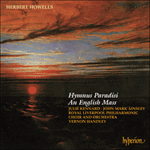
Welcome to Hyperion Records, a British classical label devoted to presenting high-quality recordings of music of all styles and from all periods from the twelfth century to the twenty-first.
Hyperion offers both CDs, and downloads in a number of formats. The site is also available in several languages.
Please use the dropdown buttons to set your preferred options, or use the checkbox to accept the defaults.

| Royal Liverpool Philharmonic Choir, Royal Liverpool Philharmonic Orchestra, Vernon Handley (conductor)» More |



The vocal scoring is particularly effective with solo voices, semi-chorus and tutti all being used to create a variety of textures and colours both between and within movements. Darke and Howells shared an enthusiasm for seventeenth-century music; throughout his life Howells felt that he ‘somehow belonged to the Tudor period’ and his rapport with the music of that time is particularly evident in this work although transmuted into Howells’s own characteristic voice. Throughout, Howells creates vivid musical images to correspond with the text and compared to Hymnus where the mood is brooding and questioning, the music of the Mass is rock sure in its faith.
The Kyrie commences pianissimo in spare two-part writing and pained semitone clashes whose discomfort is quelled by the reassuring peace of the voices entering in imitation. In richer harmonic fields the opening idea is repeated and varied to culminate in a sonorous statement, before the chorus lines fall away to silence.
After the solo bass’s declaration of faith the orchestra and chorus thunder in with their response at the opening of the Creed. This is the longest section of the Mass, and its various parts are prefaced by brief orchestral links which create the ambience for the words that follow. One of the most striking musical images occurs at the words ‘And was crucified also for us’, where the texture is pared down to a semi-chorus and a solo cello has a writhing phrase as an apt reflection of the agony of the Cross. The final section, beginning with a ravishing melody for a solo soprano at ‘And I look for the resurrection of the dead’, has the character of a coda to the movement and builds to a thrilling D major ‘Amen’ of affirmation.
By contrast, the brief ‘Sursum corda’ is a still moment of repose; a dialogue between the chant of the solo bass and the chorale-like response of the unaccompanied semi-chorus. It merges attacca into the short Sanctus which begins with a mystical melodic phrase on the oboe. In music of refined beauty the smooth, long-breathed vocal lines slowly rise to two elated climaxes exhorting the ‘Lord God of hosts’. (Particularly effective is the moment when the orchestra cuts out to emphasize the word ‘glory’.) The movement ends with a hushed sotto voce echo of praise.
The Benedictus is marked by sinewy melodies as heard in the flute solo which frames the movement. A duet for soprano and alto soloists is offset against the semi-chorus and there is a glorious change of key at the entry of the full choir at the word ‘Hosanna’. The movement is linked to the Agnus Dei which is centred around a phrase of heart-rending sadness heard in two-part counterpoint setting the words ‘O Lamb of God’. Its threefold supplication exploits several textures including solo quartet for the first time, and ends on a plea for peace.
Much of the Gloria is another of Howells’s ecstatic outbursts of praise. It opens dramatically and reaches a huge outburst on the orchestra before the tempo, and texture, change for a more reflective section at ‘O Lord, the only-begotten Son, Jesu Christ’. As the tempo quickens again, the music drives to a climax with memorable ‘word painting’ at ‘have mercy upon us’. At the end melting solos for soprano and tenor lead quietly to a hushed ‘Amen’.
from notes by Andrew Burn © 1991
 Howells: Hymnus Paradisi & An English Mass Howells: Hymnus Paradisi & An English MassRoyal Liverpool Philharmonic Orchestra, Royal Liverpool Philharmonic Choir, Vernon Handley (conductor) ‘Superb performances’ (The Daily Telegraph) ‘An outstanding performance … a wonderful tribute to Howells in his centenary year’ (Classic CD)» More |

